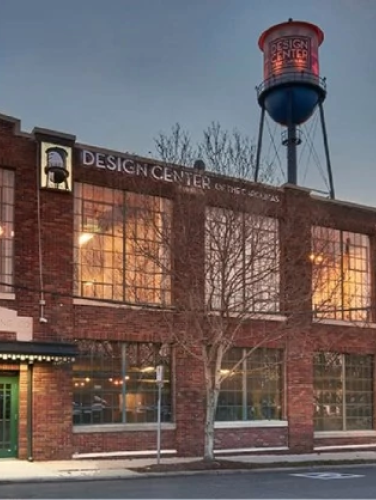
Nebel Knitting Mill
(ca. 1927)
The Nebel Knitting Mill, manufacturer of fine quality women’s hosiery, was once among the largest hosiery mills in the Southeast.
101 W Worthington Ave, Charlotte, NC 28203
William Nebel (1887-1971), a native of Germany and a third-generation hosiery knitter, established his Nebel Knitting Company in Charlotte in 1923. After emigrating to the U.S. in 1905, Nebel worked in several textile concerns in New York and New Jersey before moving to Charlotte to launch his own business. A full-fledged knitter since the age of twelve, Nebel was an innovator in hosiery styles, colors, and patterns, holding at least sixteen structural and design patents.
Property Quick Links
Nebel’s company manufactured fine quality, full-fashioned hosiery for women, and its success prompted production expansions and relocations throughout the 1920s. From its first operation – starting with only two sets of machinery on the second floor of a small East Kingston Street building – Nebel moved the company in 1925 to a South Boulevard location in Dilworth’s industrial sector before deciding to construct a new larger Nebel Knitting Mill in 1927 on West Worthington Avenue beside the Southern Railroad line. A 1929 expansion more than doubled the facility’s size. Nebel commissioned the noted Charlotte architect and engineer Richard C. Biberstein (1859-1931) to design both sections of his 1927-1929 mill complex.
Biberstein is reputed to have designed more cotton mills in this region than any other individual. The Texas native studied mechanical engineering at Worcester (Massachusetts) Polytechnic Institute. He worked in New Jersey and Indiana before relocating to Charlotte in 1887 to work as a draftsman-designer for Colonel John Wilkes, owner of the Mecklenburg Iron Works. Biberstein later worked for Hubert S. Chadwick’s Charlotte Machine Company and Stuart W. Cramer’s mill design firm before going into business for himself in 1905 as a mill architect and engineer. Among the regional mills Biberstein designed were the Boger and Crawford Spinning Mill in Lincoln County; the Hudson Cotton Mill and the Dixon Mills in Gaston County; the Imperial Yarn Mill, the Linford Spinning Mill, and the National and Chronicle Yarn Mills in Belmont; the Union Cotton Mill in Mount Holly; the Mooresville Cotton Mills in Mooresville; and the Lancaster Cotton Mill in Lancaster, South Carolina.
By World War II, Nebel Knitting Mill – the largest and most productive hosiery manufacturer in Mecklenburg County – employed approximately 350 workers at thirty-eight machines for producing nylon full-fashioned stockings. During the 1940s, the company began an aggressive national advertising campaign, including layouts in fashion magazines such as Vogue and Seventeen. By the 1950s, Nebel Mill ranked among the largest hosiery mills in the Southeast. By 1968, when the company was acquired by the Charlotte-based hosiery and apparel manufacturer Chadbourn Inc., Nebel had a workforce of 600 and produced approximately two million dozen pairs of hosiery annually. Its knitting mill building was last used by the Mecklenburg Manufacturing Company to produce children’s knitwear until 1989. The building, still Charlotte’s most intact hosiery mill, has since seen several adaptive reuses, including as restaurant and commercial space.

